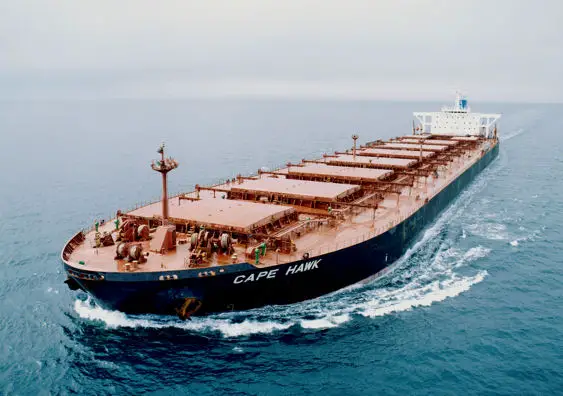Baltic Dry Index (BDI) - Important Indicator Of What Is Happening To World Trade
The Baltic Dry Index provides an assessment of the price of moving the major raw materials by sea and is one of leading economic indicators predicting future economic activity.
The Baltic Dry Index (BDI), which covers Handymax, Panamax, and Capesize dry bulk carriers, is tracking shipping prices of worldwide dry bulk cargoes carrying a range of commodities including coal, iron ore and grain in 26 shipping routes measured on a time-charter and voyage basis.
The Baltic Dry Index, which value is issued daily by the London-based Baltic Exchange - brokers global exchange for shipping contracts, simply provides an assessment of the price of moving the major raw materials by sea.
How Is Baltic Dry Index Calculated
BDI is calculated daily in a very natural process of Baltic canvasses brokers calling around the world and asking for the price of shipping various cargoes of raw materials on different routes, considering all the important variables like type and speed of the ship or voyage length. They ask how much it would cost to ship 150,000 tons of iron ore from Australia to South Africa for example.
Baltic Dry index is based on US dollars, so it is also influenced by changes in the value of the US dollar. Daily value of the index can be accessed on a subscription basis directly from the Baltic Exchange as well as from major financial information and news services, like Bloomberg.
Baltic Dry Index Composition
The indexes consists only out of specific ships transporting raw materials and dry bulk, while other ships transporting finished goods or container ships for example, are not included in the calculation. In terms of sizes, all the major oceangoing transport vessels are factored:
| Ship Class | Dead Weight (in Tons) | % of World Fleet | % of Dry Bulk Traffic |
|---|---|---|---|
| Capesize | 100,000+ | 10% | 62% |
| Panamax | 60,000-80,000 | 19% | 20% |
| Supramax | 45,000-59,000 | 37% | 18% w/Handysize |
| Handysize | 15,000-35,000 | 34% | 18% w/Supramax |
Another index, the HARPEX, focuses on containers freight. It provides an insight on the transport of a much wider base of commercial goods than commodities alone.
Baltic Dry Index Daily Chart
Incredible growth of China and some other emerging markets economies drew the Baltic Dry Index to all-time high just before the last financial crisis on 05-20-2008, when index reached intraday level of 11,793 points. The major reason for such high growth of the index value is higher China demand and imports of commodities, constrained supply of ships and port congestion. After the last financial crisis index dropped significantly to the latest minimal value reached in November 2009; index fell 94% to 663 points. There are doubts among experts what is BDI actually signaling stronger, the supply of ships or the demand for their cargos.
For interactive chart please visit StockCharts.com.
Factors Influencing Baltic Dry Index

The demand for shipping is very elastic and varies with the amount of cargo that is being traded or moved in various markets. On the other side, the supply of cargo ships is generally very tight and inelastic - it takes two years to build a new ship while it is too expensive to take them out of circulation. So marginal increases in demand can push the index higher quickly, and marginal demand decreases can cause the index to fall rapidly.
Commodity Demand
The main drivers of commodities demand are energy needs and industrial production cycle. Strong commodity demand (like from China for example) drives BDI rates higher regardless of the price of commodities themselves. Companies with spot contracts will be willing to pay more in such circumstances.
Fleet Supply
Fleet supply depends on the number of available ships, their capacity and utilization. The major problem with fleet supply is that it is very inelastic in the short term. It takes two years for the ship to be build and it lasts for 25 years afterwards. Old worldwide fleet indicates decreasing short term supply.
Seasonal Pressures
Season also plays a great role in BDI value, since it has impact on demand on one side (cold weather increases the demand for energy related raw materials), and on logistics on the other side (cold weather and ice causes trouble in ports). Mild winters are therefore what transporters are hoping for.
Bunker Fuel Prices
Bunker fuel oil prices, which is used by ship for propulsion and it represents around 30% of operating costs, depend on crude oil prices; the higher they are, the higher BDI value you can expect.
Narrow Shipping Lanes
Narrow lanes, like Panama canals and Suez among four majors for example, present natural limitations in bulk tonnage capacity, since only limited number of ships can pass through the lanes each day.
Market Sentiment
Like with any other markets, market sentiment together with forecasting raw materials demand plays a great role in the BDI value as well.
Port Infrastructure
Each port is limited on its own with actual terminal infrastructure, which is simply representing the cap of ships that can be handled per day.
Labor Relations
The human part of shipping process shouldn't be underestimated. Workforce is the one loading or unloading the ships and work related conflicts around the globe can influence BDI directly.
Piracy
Organized criminal groups are affecting shipping for years and put additional pressure on the value of BDI.
New Shipping Routes
Arctic shipping routes are not distance friendly, but may be economical as well if the oil prices are low.
Why Is Baltic Dry Index Important For Stock Investors
Most directly, the index measures the demand for shipping capacity versus the supply of dry bulk carriers. Indirectly index measures global supply and demand for the commodities shipped aboard dry bulk carriers, such as building materials, coal, metallic ores, and grains. Because dry bulk primarily consists of materials that function as raw material inputs to the production of intermediate or finished goods, such as concrete, electricity, steel, and food, the index is also seen as an efficient economic indicator of future economic growth and production.
The BDI is termed a leading economic indicator because it predicts future economic activity. Movements in the Baltic Index tend to precede movements in global stock markets. But the index also tends to presage higher interest rates. When more stuff is being shipped around the world, it needs to be financed. And that creates a greater demand for credit.
Unlike stock and bond markets, the BDI is totally devoid of speculative content. The trading is limited only to the member companies, and the only relevant parties securing contracts are those who have actual cargo to move and those who have the ships to move it.
List Of Shipping Stocks
There are some similarities between the value of Baltic Dry Index and price movement of shipping stocks. However, the correlation depends on how the companies contract the price of BDI, spot or future. In case of spot contracting, revenues of the company are directly connected with BDI value; the higher the BDI, the greater profits you can expect if everything else equal. In case of future contracting (few years in advance usually) the BDI price is fixed for the companies, therefore providing less profit volatility and guaranteed cash flows.
Here is a list of 20 dry bulk shipping stocks trading on U.S. stock exchanges, ordered by market capitalization in $ Millions on 07-27-2010.
| Company | Symbol | Stock Exchange | Market Cap |
|---|---|---|---|
| Frontline | FRO | NYSE | 2,620 |
| DryShips | DRYS | NASDAQ | 1,330 |
| Diana | DSX | NYSE | 1,100 |
| Seaspan Corp. | SSW | NYSE | 718 |
| Navios Maritime Holdings | NM | NYSE | 589 |
| Genco | GNK | NYSE | 545 |
| Navios Maritime Partners | NMM | NYSE | 534 |
| Safe Bulkers | SB | NYSE | 499 |
| Excel Maritime | EXM | NYSE | 461 |
| Eagle Bulk | EGLE | NASDAQ | 299 |
| Paragon Shipping | PRGN | NYSE | 212 |
| TBS Int. | TBSI | NASDAQ | 188 |
| International Shipholding Corp. | ISH | NYSE | 180 |
| Star Bulk Carriers Corp. | SBLK | NASDAQ | 160 |
| Euroseas | ESEA | NASDAQ | 111 |
| OceanFreight | OCNF | NASDAQ | 76 |
| Seanergy Maritime Holdings | SHIP | NASDAQ | 73 |
| Danaos Corp. | DAC | NYSE | 54 |
| FreeSeas | FREE | NASDAQ | 37 |
| Omega Navigation | ONAV | NASDAQ | 19 |
You can check current bulk shipping stocks quotes and real-time charts on Google Finance. Just type in the symbol...
Written by: Goran Dolenc
Do you find this content useful? Like! Tweet! Recommend! Share!
Back from Baltic Dry Index to Investing in Stock Market
Back from Baltic Dry Index to Best Online Trading Site for Beginners home page







